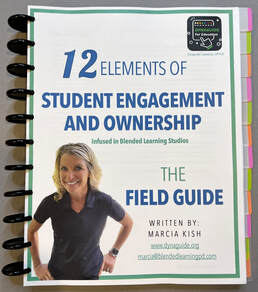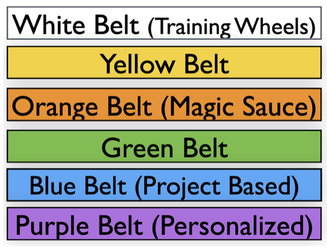An Overview of
|
|
|
The 12 Elements of Student Engagement and Ownership were designed from the key elements of a blended learning classroom, where the students work at their own pace, place, path, and data-driven small group instruction. Breaking down the Three Phases of Blended into bite-size increments became a new focus for my instructional coaching career. For ten years, as an Instructional Coach, I created The Three Phases of Blended Learning, where the classroom teachers learned how to gradually move away from whole group instruction to the station rotation model, to differentiated instruction, and finally, Phase Three, where the students were able to showcase the understanding of the learning standards through the deployment of large projects. The Three Phases of Blended Learning program was highly successful with the onsite coaching, professional development opportunities, and ongoing support. At this point, we are still coaching teams on how to deploy blended learning through the Three Phases of Blended Learning. However, the need for personalized professional development opportunities has grown drastically with the teacher turnover rate and various teaching styles.
|
The 12 Elements of
Student Engagement and Ownership
Small-Group Instruction: Breaking apart the large group instruction into learning studios where the teacher differentiates the instruction while other students work on independent work, relearn the standards through Digital Content, and small projects reinforce the standards.
Data-Driven Learning Environments: Utilizing the formative, summative, and online digital data to differentiate the learning studio activities.
Checklist: Designing student ownership opportunities within the classroom that allow the students to pick a variety of learning tasks that align with the daily “I Can Statements.”
Student Choice and Ownership: Employ creativity choice boards within the hands-on learning studio that promotes online and offline projects that fit the student learning styles.
Pace: Recognize that all students work faster and slower on mastering the learning objectives. The students will be able to work, collaborate, create, and express their understanding of the content within a given time frame.
Place: Prepare online and offline learning activities that align with the small group instruction studio.
Path: Allow the students to explore the checklist and prioritize the learning studios they want to complete first, second, and third.
Digital Content Studio: Construct online learning opportunities that align with the learning objectives and provide quality data that can be used to drive small group instruction with the awareness of the amount of screen time within one class period.
Independent Practice Studio: Students can practice, explore, and dive deeper into the learning objectives while the teacher is conducting a small group studio.
Hands-on Learning with the inclusion of Project-Based Learning: Explore or demonstrate the understanding of the learning objectives through collaboration, creativity, communication, or critical thinking application projects.
Organization: Designing a classroom environment that provides organizational methods that allow the students to work through the content at their own pace, place, and path.
Directions: Increase student ownership through voice, visual, and virtual links that showcase the steps the students need to take to complete the given task.
Data-Driven Learning Environments: Utilizing the formative, summative, and online digital data to differentiate the learning studio activities.
Checklist: Designing student ownership opportunities within the classroom that allow the students to pick a variety of learning tasks that align with the daily “I Can Statements.”
Student Choice and Ownership: Employ creativity choice boards within the hands-on learning studio that promotes online and offline projects that fit the student learning styles.
Pace: Recognize that all students work faster and slower on mastering the learning objectives. The students will be able to work, collaborate, create, and express their understanding of the content within a given time frame.
Place: Prepare online and offline learning activities that align with the small group instruction studio.
Path: Allow the students to explore the checklist and prioritize the learning studios they want to complete first, second, and third.
Digital Content Studio: Construct online learning opportunities that align with the learning objectives and provide quality data that can be used to drive small group instruction with the awareness of the amount of screen time within one class period.
Independent Practice Studio: Students can practice, explore, and dive deeper into the learning objectives while the teacher is conducting a small group studio.
Hands-on Learning with the inclusion of Project-Based Learning: Explore or demonstrate the understanding of the learning objectives through collaboration, creativity, communication, or critical thinking application projects.
Organization: Designing a classroom environment that provides organizational methods that allow the students to work through the content at their own pace, place, and path.
Directions: Increase student ownership through voice, visual, and virtual links that showcase the steps the students need to take to complete the given task.
The Field Guide
The Field Guide for the 12 Elements of Student Engagement and Ownership Infused in Blended Learning Studios is designed for the coaches, administrators, and classroom teachers who enjoy seeing the layout and progression of how each element increases student ownership in written form. The step-by-step guide provides suggested strategies for classroom teachers to implement, visual descriptions of the strategies, and titles for the coaching videos found on dynaguide.org.
The Belt Colors for theField Guide and Dynaguide
While breaking down the Three Phases of Blended Learning into the 12 Elements of Student Engagement and Ownership, I decided to utilize the strategy I saw inside the Algebra classroom in Bellefontaine High School with the karate belt colors as a level-up organization system. Each of the twelve elements has a total of six level-up belt colors. The color guide below showcases the level-up sequence.
While breaking down the Three Phases of Blended Learning into the 12 Elements of Student Engagement and Ownership, I decided to utilize the strategy I saw inside the Algebra classroom in Bellefontaine High School with the karate belt colors as a level-up organization system. Each of the twelve elements has a total of six level-up belt colors. The color guide below showcases the level-up sequence.
I refer to the White and the Yellow Belt strategies as the training wheels for the elements of student and ownership infused in blended learning studios due to the fact that it breaks down the concepts into manageable pieces. The Orange and Green Belt strategies start to integrate data to help differentiate the small group instruction, provide choice learning activities for the students, and design a classroom environment that allows the students to work at their own pace, place, and path. I call these two belt colors the “Magic Sauce” for higher levels of student engagement and ownership. The last two belt colors, Blue and Purple, showcase how to implement in-depth projects and personalized learning elements for the students.
By following the belt color guide, the teachers and the students gradually build up to the next level of implementation strategies without feeling so overwhelmed. The Field Guide generates suggested strategies and integrates a personalized professional development plan for good teaching techniques with the belt levels.
By following the belt color guide, the teachers and the students gradually build up to the next level of implementation strategies without feeling so overwhelmed. The Field Guide generates suggested strategies and integrates a personalized professional development plan for good teaching techniques with the belt levels.


